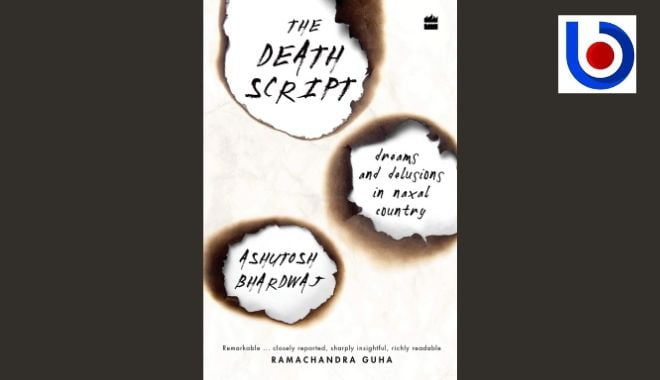A Story Of The Dead: The Death Script
Book Review The Death Script: Dreams and Delusions in Naxal Country Author: Ashutosh Bhardwaj. Publisher: Fourth Estate, 2020. PP. 269. Price: 599

The folios of government records, which subsequently become a part of authentic history, do not reserve a space for the struggle of existence. Ashutosh Bhardwaj’s latest book, The Death Script: Dreams and Delusions in Naxal Country, disturbs our collective psyche and our consciousness of being a subject of the largest democratic nation.
In seven chapters spread across 253 pages that draw on his numerous trips to Bastar and across the Red corridor of India, Bhardwaj sketches the struggle for power and the stranded lives of the undecorated citizens whose constitution of deprivation is decided before their birth (91). The records of dishonesty, subversiveness and betrayals narrated in multiple voices might shatter our delusions regarding the Indian state and the role of the ideological and repressive apparatuses that trumpet the glory of our political leadership.
Corpses of innocent people do not make news. Bhardwaj earned his badge as a journalist in the jungles of Batsar, which he calls a museum of death, by extracting the hidden falsity behind the excessively mutilated corpses. As a reader my breath stopped when I reached page 24 where Bhardwaj records his first encounter with more the awful taxidermy of 15 corpses on June 30, 2012, which the state claimed as the biggest ‘encounter killing’ of Maoists in Chhattisgarh. The screaming of the relatives of the dead begging him to take photographs of their loved one’s naked bodies, hoping to get some kind of justice, constitutes ample proof that they were not killed in a gunfight but were brutalized until their last breath. It included a boy of 15, who was termed a ‘notorious Maoist’ by the then home minister of India. “Two years later, before an inquiry commission in July 2014, he was not able to state the reason for not being able to take the photographs. ‘I was petrified by the sight of a heap of corpses,’ you state under oath, ‘and found it inhumane to store the naked bodies of children’—among the deceased was a 12-year-old girl—‘in my laptop merely to secure some evidence and make the report appear more authentic” (25). The trauma of the ‘death reporter’ in him never had ‘such doubts … in the future, and … never flinched before taking photographs of the corpses’ (25).
This book is drawn from his numerous trips to Bastar over 100 months across the last decade, and his unfortunate responsibility as a journalist of recording over 200 deaths during this period. No true news comes to us without a price, which is sometimes paid by the journalist and at other times by the subjects. The commercial agenda of journalism also finds its reflection in The Death Script. It raises crucial questions about the fidelity of being a journalist in an age of abundance of news and gives a detailed account of the case of the Raipur journalist Prafulla Jha, the growth of Maoism in Batsar, the conversion of the adivasi zone into their laboratory, the case of Alex Paul Menon, the collector of Sukma who was abducted, the only two journalists who have received Nobel Prize for literature, the curious case of the surrendered Maoist and the state-sponsored postmortems.
I would argue that Bhardwaj is a journalist and author who takes no sides, but instead tries to reflect the ground reality as it exists. He offers at times a different picture which might be hard to digest during a time when both the state and the Maoists try to win sympathy of the masses for their modus operandi. He presents accounts of people who recall the atrocities of the Maoists. To quote him “…If they wanted to kill a person, they forced his parents to throw stones at him…This is my land. I don’t want the Maoist here” (75). He also comments on the alleged nexus between the Maoists and the capitalists, thereby exposing the hidden hand of Indian corporations. There is never any attempt to justify crime and killings.
The book covers a lot of ground, from Abujhmad, the only place not to be surveyed in India, to the story of AK 47, to the family of Devti and her four sons, perhaps the only family in India that has five members with Z- plus security, to the position of women cadres in the Maoist structure, to cow politics, to the industrialization that followed the Independence, which was the first cause of rural displacement, to second stage of exploitation of mineral resources and to the third stage of expansion of urban centres among others. The book displays a large amount of research and the inquisitiveness of the journalist, which can be found in his exhaustive footnotes. The use of references from the epics Mahabharata and Ramayana makes the book interesting.
The book is marked by trauma in its very structure, which is deeply fragmented and scattered across the pages. It is composed of chronological diary entries by Bhardwaj. While this (dis)organisation of the events in the book can be distracting, it is a suitable vehicle for the delineation of the trauma of violence. By keeping these incidents in the books scattered and fragmented he sketches a different picture of reality which at times helps the reader to reach for the truth hidden behind the news columns.

Comments are closed.